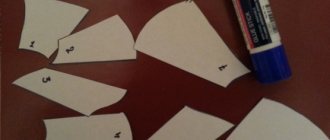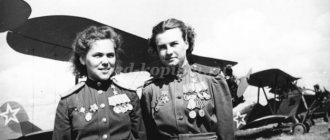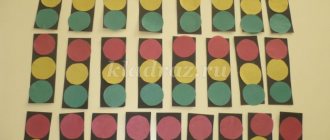Speech therapy lesson in the senior group of a preschool educational institution on the topic “Insects”
- October 18, 2015
Competition “My Pedagogical Initiative - 2015”
Nomination “Methodological work in preschool educational institutions”
The lesson notes have been developed for children of senior preschool age who have a general speech disorder.
Goal: Development of coherent speech using mnemonics.
Tasks:
- activation of the dictionary on the topic “Insects”;
- consolidation and development of the ability to compose a descriptive story according to a plan-scheme;
- strengthening the ability to correctly coordinate numerals and nouns;
- development of attention, visual perception, fine motor skills, memory;
- nurturing love and respect for native nature.
Demonstration material: “Bee” toy, a plan diagram for compiling a descriptive story of an insect, a picture with a schematic image of a butterfly, a ball, paper bees, pictures of insects.
Handouts: boxes with counting sticks, cards with images of insects.
Progress of the lesson
Organizing time. The speech therapist and children are part of the group.
Speech therapist: Children, guests came to our lesson today. Say hello to them (say hello).
Speech therapist: Stand in a circle next to me (takes the ball). Let's play a game.
“Say the opposite” (the speech therapist throws a ball to the child, who returns the ball back - all this is done simultaneously with a verbal selection of antonym words):
The mosquito is evil, but the butterfly, on the contrary, is kind. The bumblebee is big, and the ladybug... is small. The bee is useful, but the fly... is harmful. The wasp lives on the street, and the cockroach... lives at home. The grasshopper jumps, and the ant... crawls. The beetle is buzzing, and the spider... is silent. A dragonfly flies quickly, but a mosquito... flies slowly.
Speech therapist: Who are a mosquito, a fly, a grasshopper, a butterfly?
Children: Insects.
Speech therapist: What other insects do you know?
Children: Dragonfly, ant, cockroach, etc.
Speech therapist: One insect flew to us today. Guess who it is:
He drinks the juice of fragrant flowers and gives us wax and honey. She is sweet to all people. And her name is... (bee).
Speech therapist (shows the “Bee” toy): She arrived not alone, but with her little bees. Oh, guys, look, what did the bees bring us?
Children: Flowers.
Speech therapist: That's right, flowers (the speech therapist takes the first flower and sees the task). Guys, the flowers are not simple, there is something written on them, let’s read it. (The speech therapist reads the first task).
Speech therapist: Guys, the bee invites us to meet her friends. But first we must find them. Look at our clearing, and whoever found it, raise your hand. Begin your statement with the words “I found...”.
(Children take turns naming the hidden insects. The speech therapist hangs the corresponding picture on the board).
Speech therapist: Here they are - the bee’s friends! Guys, do you know that among insects there are beneficial and harmful insects. Name the beneficial insects.
Children: Butterfly, bee, ant.
Speech therapist: What benefits do bees, butterflies, and ants bring?
Children: Bees pollinate flowers, give us honey and wax. Ants carry seeds of many plants throughout the forest. Butterflies pollinate flowers.
Speech therapist: Name the harmful insects.
Children: Fly - spreads germs, caterpillar - eats plant leaves, mosquito.
Speech therapist: Listen carefully to the second task (takes the second flower and reads the task). Guys, the bee invites you to tell us about her insect friends using this diagram.
Speech therapist (opens the next petal): Bee invites us to play a game called “Guess who I am?”
(Selecting a noun for the verb that matches its meaning, playing with a ball)
Flutters (who) - a butterfly Buzzes - a beetle Rings - a mosquito Collects honey - a bee Stings - a wasp Jumps - a grasshopper Works - an ant Flies - a dragonfly.
Speech therapist: Guys, let's show the bees how we can buzz beautifully and ring.
Children: Zh-zh-zh, z-z-z-z.
Speech therapist: Now let’s repeat after the bee:
Zha-zha-zha – we saw a hedgehog. Zhi-zhi-zhi - hedgehogs live under the bush. Zhi-zhi-zhi - hedgehogs are running. Zhu-zhu-zhu - let's give milk to the hedgehog. Zhu-zhu-zhu - I’ll help the hedgehog. Jo-jo-jo - I'm driving a Peugeot.
For-for-for - here comes the goat. For-for-for - here the dragonfly flies. For-for-for - the doll has blue eyes. Zu-zu-zu - I'll feed the goat. Zu-zu-zu - I'm not afraid of a goat. Zy-zy-zy - no goat. Zy-zy-zy - I have two goats. Zya-zya-zya - we saw ide. Zi-zi-zi - bring some tires.
The speech therapist picks off the fourth flower. This flower says that our bee wants to turn us into centipedes. Get up on your feet and repeat after me.
Physical exercise “Centipede”.
1. A centipede walked (children walk with a rhythmic step, slightly springing) along a dry path. 2. Suddenly it began to rain: Drip-drip-drip! (children stop and crouch.) - Oh, forty paws will get wet! 3. I don’t need a runny nose (the children walk, raising their knees high, as if they are walking through puddles), - I’ll go around the puddles! 4. I won’t bring dirt into the house (the children stop and shake one leg), - I’ll shake it with each paw! (shakes the other leg). 5. And then I’ll stomp (children stomp their feet) - Oh, what thunder from the paws!
Speech therapist: Well done guys! Take a seat. Which flower do we pick off?
Children: Fifth.
Speech therapist: Guys, our bee asks us to count whether all her babies are in place. Shall we help the bee? Let's start counting. One bee, two bees and...
Speech therapist: Guys, let's see what the smallest bee has prepared for us.
Speech therapist: And now the bees offer us to play with counting sticks. (Tears off a flower). Guys, take the counting sticks out of the boxes and make a butterfly out of them. You can look at the sample, or you can come up with your own butterfly. (Children complete the task).
Speech therapist: Well done! You have completed all the tasks. Now lie back, close your eyes and listen to me.
Relaxation (to music):
The eyelashes droop, the eyes close. We rest peacefully, fall asleep in a magical sleep, Breathe easily, evenly, deeply. The tension has flown away and the whole body is relaxed. It's like we're lying on the grass, on green soft grass. The sun is shining now. Our hands are warm, our feet are warm. Breathe easily, evenly, deeply. Our hands are resting, Our legs are also resting, They are resting and falling asleep. It's good for us to rest, But it's time to get up. Let's raise our heads higher and breathe easily. Oh, how it smells like spring here. But it's time for us to go home!
Lesson summary
- Our lesson has come to an end. Tell me, who did we talk about today? (We talked about insects.)
– What did you like most? What was difficult for you? (Children answer questions).
Author: Anufrieva Anastasia Aleksandrovna, teacher-speech therapist of MKDOU kindergarten No. 499 “Gnezdyshko”, Novosibirsk.




